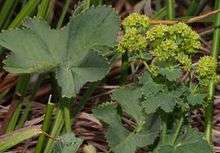Alchemilla diademata
Alchemilla diademata, also known as the diadem lady's mantle[1] (Arabic: كمالية مكللة), is a species of the genus Alchemilla endemic to Lebanon.[2][3][4] The plant has been commonly used in folk medicine in Lebanon and its promising bioactive properties have been subject to a number of studies.[5][6]
| Alchemilla diademata | |
|---|---|
 | |
| In its natural habitat | |
| Scientific classification | |
| Kingdom: | Plantae |
| Clade: | Tracheophytes |
| Clade: | Angiosperms |
| Clade: | Eudicots |
| Clade: | Rosids |
| Order: | Rosales |
| Family: | Rosaceae |
| Genus: | Alchemilla |
| Species: | A. diademata |
| Binomial name | |
| Alchemilla diademata | |
Description
Alchemilla diademata has an erect 10 to 15 cm (3.9 to 5.9 in) high stem. The stem is highly pubescent at the base, the trichomes become less dense at the tips. The leaves are basal and measure 3 to 4 cm (1.2 to 1.6 in) wide and 2 to 3 cm (0.79 to 1.18 in) wide; they resemble lobed kidneys with an oval with an inward curve on one side The leaves are incised to the third into 7 to 9 lobes, each of them fringed by 6 to 7 teeth on each side of the lobes. The teeth end with bristles and are slightly connivent. The leaf underside is hispid and its sinus is cordate. The plant has long, membranous and brownish stipules; it has a yellow-green pedicellated and glabrous inflorescence. The ovoid flowers appear from May to July, they produce ovoid and urn-shaped fruits.[2][7]
Distribution and habitat
The plant is only found on the slopes of Mount Sannine in the Mount Lebanon range; it favors humid sandstone.[2][7][8]
Research and uses
Medicine
A 2004 screening of Lebanese indigenous plants that have historically been used in folk-medicine conducted in the American University of Beirut Nature Conservation Center laboratories showed that A. diademata extract had an antimicrobial activity against Staphylococcus aureus.[2][5] Later studies showed that the plant also has anti-fungal activity against Candida albicans.[9]
Biological pest control
A 2014 study investigating the biological activity of Lebanese indigenous medicinal plants showed that whole plant extracts of A. diademata has a significant repellent effect against the adult silverleaf whitefly, an important invasive agricultural pest.[6]
References
- "LDLP – Librairie Du Liban Publishers". www.ldlp-dictionary.com. Retrieved 2016-12-22.
- "AUB NCC Plant Database". plants.aub.edu.lb. American University of Beirut. Retrieved 2016-12-22.
- Efe, Recep; Ozturk, Munir; Ghazanfar, Shahina (2012-03-15). Environment and Ecology in the Mediterranean Region. Cambridge Scholars Publishing. ISBN 9781443838030.
- "Catalogue of Life – 2014 Annual Checklist :: Species details". www.catalogueoflife.org. Retrieved 2016-12-22.
- Barbour, Elie K; Al Sharif, Mohammed; Sagherian, Vatche K; Habre, Adele N; Talhouk, Rabih S; Talhouk, Salma N (2004-07-01). "Screening of selected indigenous plants of Lebanon for antimicrobial activity". Journal of Ethnopharmacology. 93 (1): 1–7. doi:10.1016/j.jep.2004.02.027. PMID 15182897.
- Hammad, E. Abou-Fakhr; Zeaiter, A.; Saliba, N.; Talhouk, S. (2014-01-01). "Bioactivity of Indigenous Medicinal Plants against the Cotton Whitefly, Bemisia tabaci". Journal of Insect Science. 14 (105): 105. doi:10.1673/031.014.105. PMC 4212871. PMID 25204756.
- "Lebanon FLORA". www.lebanon-flora.org (in French). Université Saint Joseph de Beyrouth. Retrieved 2016-12-22.
- Davis, Stephen D.; Heywood, Vernon Hilton; Hamilton, Alan Charles; Nature, World Wide Fund for; Resources, International Union for Conservation of Nature and Natural (1994-01-01). Centres of plant diversity: a guide and strategy for their conservation. World Wide Fund for Nature (WWF) and IUCN-The World Conservation Union. ISBN 9782831701974.
- Giordani, C.; Santin, R.; Cleff, M. B.; Giordani, C.; Santin, R.; Cleff, M. B. (2015-03-01). "Survey of plant extracts with anti-Candida activity in the 2005–2013 period". Revista Brasileira de Plantas Medicinais. 17 (1): 175–185. doi:10.1590/1983-084X/12_072. ISSN 1516-0572.